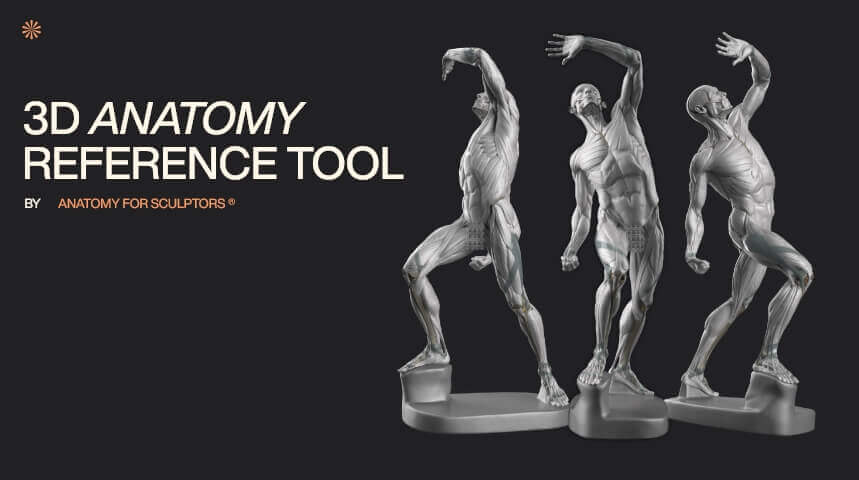
3D Anatomy models for artists
3D Reference Tool is much more than just a library of scans. Here, you will find 3D anatomy references – block-outs, anatomy models, and realistic assets – to help you understand and create realistic human anatomy.
The upper limb consists of 30 bones if you don’t include the two bones of the shoulder – the scapula and the clavicle. Regardless of how you count, the arm features many bones and many bony landmarks of the arm are visible in the human body’s surface forms.
In this article, we’ll describe and illustrate the bony landmarks of the arm as well as explain the morphology and physiology of the main bones of the upper limb. We’ll look at the bony landmarks of the upper arm, the elbow, the forearm, and the wrist.

Sometimes the two bones of the shoulder – the scapula and the clavicle – are also counted as a part of the upper limb. If you’re interested in exploring the bony landmarks of the shoulder, we have a separate article on this topic here!
Want to learn more about dynamic movements of the arm? Our newest book is coming soon – Arm and Hand in Motion.
The humeral head is one of the bony landmarks of the arm at the spot where the shoulder connects with the upper limb – the glenohumeral joint. At this joint, the scapula articulates with the humerus, the only upper arm bone.
The humeral head is round and articulates with the scapula’s very shallow glenoid cavity. That makes this multiaxial joint exceptionally mobile, and it’s one of the reasons why our arms have such an enormous range of motion. It’s also the main reason for easily dislocated shoulders – but that is a story for another blog!

One of the bony landmarks of the arm is the humeral head that fits into the glenoid cavity forming the glenohumeral joint.
The humeral head is big and round, and it’s clearly visible in the surface forms of the human body. Even if the person is quite fit, the ball is sticking out in the front of the shoulder, and you can quickly locate it – the acromion process covers it on the top, and the coracoid process closes the structure from the medial side.

The humeral head is one of the bony landmarks of the arm that is visible in the sihlouette of the shoulder.
Numerous bones come together in this area, all of which are close to the skin’s surface. As a result, we can find a lot of different forms here! As you can see in the picture below, first, there’s a sharp point where the clavicle sticks out of the shoulder.
Afterward, there is a flat spot because of the acromion process, followed by a rounded surface form created by the humeral head at the beginning of the arm. Below that, the convex form of the upper arm is created by the volume of the deltoid muscle.
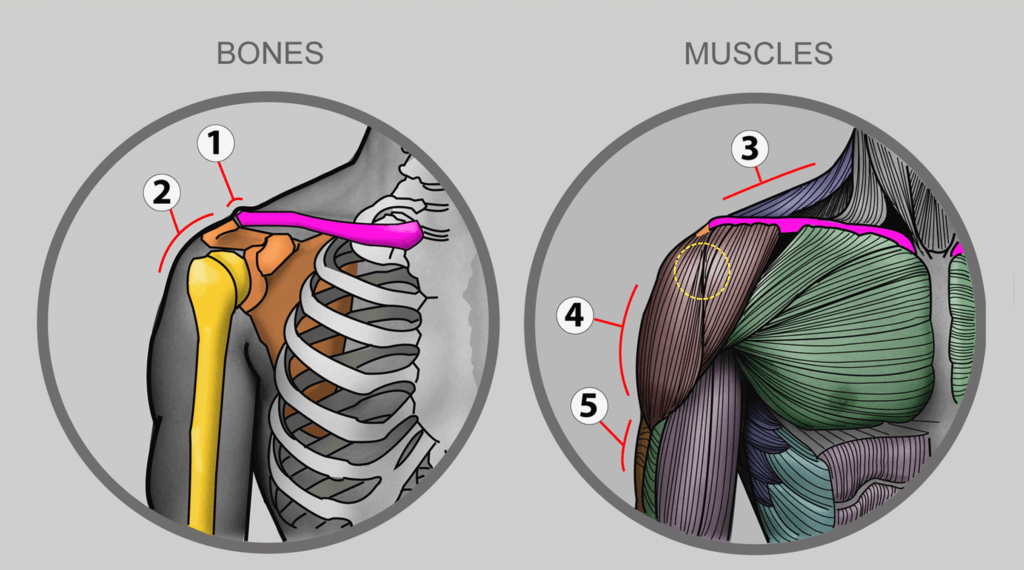
The bony landmarks of the arm influence the sihlouette of the shoulder. Lateral end of the clavicle (1) protrudes, the humeral head (2) pushes the deltoid outward. The muscles influencing the sihlouette are the trapezius (3), deltoid (4), and triceps (5).
The humeral head is so visible because the deltoid muscle that covers it is, at that point, quite thin. The bulk of the deltoid muscle is a bit lower, under the humeral head.
The deltoid muscle continues almost until the middle of the upper arm and inserts into the deltoid tuberosity on the humerus. The deltoid tuberosity is a bit above the middle point of the humerus.

The deltoid tuberosity serves as the insertion point for the deltoid. It’s located a bit above of the middle point of the humerus.
When you depict the deltoid in your work, it is essential to know all these reference points. You can think about the deltoid in three steps. You start with the muscle’s origins in three places on the shoulder girdle – the spine of the scapula, the acromion process, and the acromial third of the clavicle.
Then you have to remember that the muscle is thin at first, and the humeral head is visible through it, after which the bulk of the muscle follows. You finish by inserting the muscle into the deltoid tuberosity located a bit higher than the middle of the upper arm.
Elbow bony landmarks include the two protrusions on the humerus and the one on the ulna. Regarding bony landmarks, nothing else interesting happens on the upper arm until we reach the elbow. There the humerus articulates with the ulna and radius, the forearm bones.
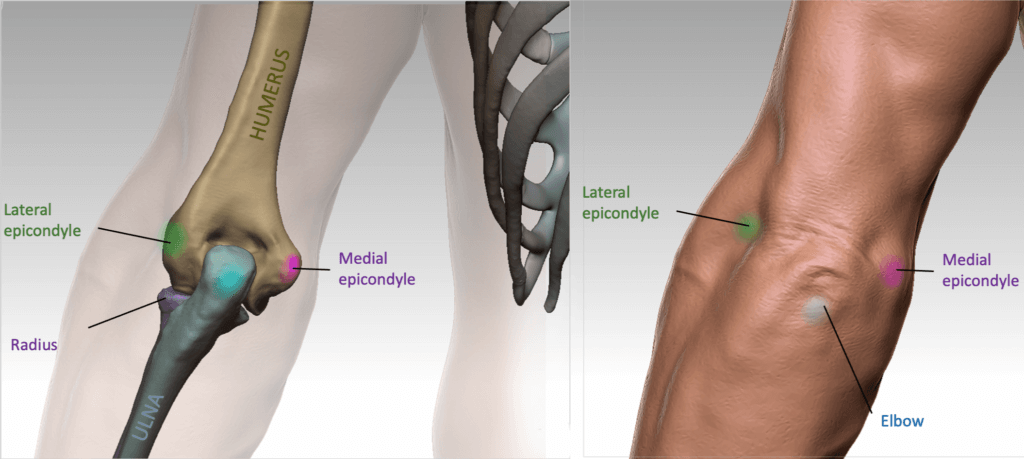
Elbow bony landmarks include the medial epicondyle, lateral epicondyle, and olecranon.
The elbow bony landmarks created by the humerus and seen on the surface forms are the medial and lateral epicondyle. The medial epicondyle sticks out and is visible both in the frontal and rear views.
The lateral epicondyle is located in a dimple between the elbow and two muscles – the brachioradialis and the extensor carpi radialis longus. The dimple of the lateral epicondyle can only be seen in the rear and lateral views.
The third bony landmark of the elbow is the olecranon, which most of us recognize as “the” elbow. It’s a large bony eminence of the ulna, and this is where the forearm begins. Out of all the three bony landmarks of the elbow, the olecranon is the only mobile one.
Since the olecranon moves, the arm actually becomes longer when bent. When the arm is straight, the distance from the shoulder to the elbow is shorter than when bent.

The olecranon is one of the elbow bony landmarks that moves. When the arm is bent, the olecranon moves and the arm becomes longer.
The arm can’t bend backward because the hook-shaped protrusion behind the olecranon fits into a groove on the humerus called the olecranon fossa and fixates when the arm is straightened.
Unlike the upper arm, which is covered by the deltoid, biceps, triceps, and brachialis muscle, the forearm has several visible bony landmarks. The ulna creates all these landmarks.
The forearm comprises two bones, the ulna and the radius. It is often said that the ulna and the radius are parallel, but it is valid only when the arm is held in the so-called anatomical position.
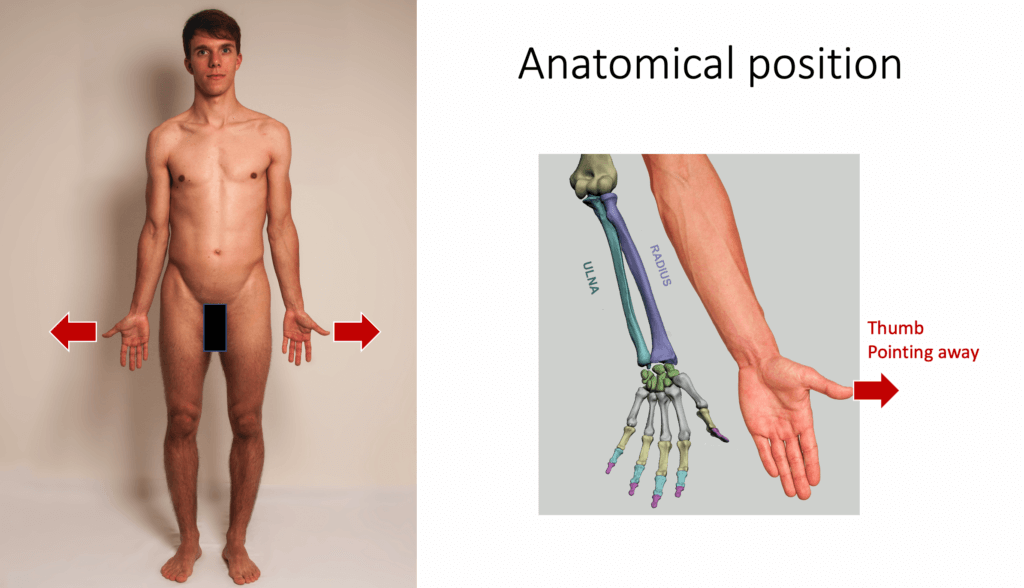
In the anatomical position, the palms are facing forward and the thumbs are pointing laterally.
In the anatomical position, the palms face forward, and the thumbs point laterally. This position is not very casual, and most of your artworks will not feature characters depicted like this. Still, it’s helpful to imagine this position to better understand the bones’ orientation.
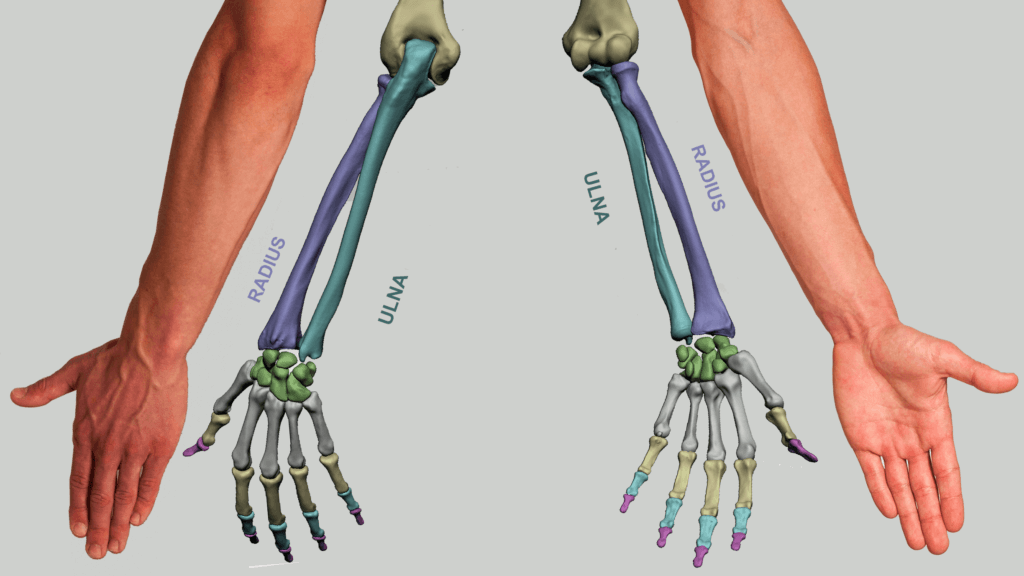
The bones of the forearm, the ulna and radius are parallel only when the arm is held in the anatomical position.
The radius is the bone on the side of the thumb, and the ulna is the bone on the side of the pinky. Because of this, the lateral side of the forearm is often referred to as the radial side, and the medial side of the forearm is called the ulnar side.
At first glance, the two bones look different in size, but they are almost the same – just inverted. You can find a similar thing in the lower limb, where the tibia and fibula are also the same length (but not the same size because the tibia is more massive) and inverted.
That appears to be the case for the limbs of many other animals too. When running, this inverted design protects the animals’ joints from extra stress and provides cushioning.

The ulna and radius are almost the same, just inverted. The ulna doesn’t articulate with the bones of the hand.
Both bones articulate with the humerus on the proximal side at the elbow. The humerus features a spool-shaped condyle consisting of two parts: the ball part (capitulum) articulates with the narrow cylindrical end of the radius, and the larger medial surface of the condyle (trochlea) articulates with the wide end of the ulna.
However, on the distal end, everything is inverted: the radius features a wider end, and the ulna has a narrow cylindrical end. While the radius articulates with the bones of the hand, the ulna doesn’t. There’s some free space between the ulna and the bones of the hand that makes this joint more flexible.
The ulna holds all of the bony landmarks of the forearm. On the wrist, we can see the distal head of the ulna. You can find it by moving up along the side of your pinky finger and stopping at the place where your wristwatch would go. It’s very noticeable, and you can easily feel it with palpation.
The other bony landmark of the ulna is at its proximal end – the olecranon that we already looked at when talking about the elbow. If you draw a line between the olecranon and the distal head of the ulna, you’ll find the body of the ulna. It’s close to the skin’s surface for the whole length of the forearm.
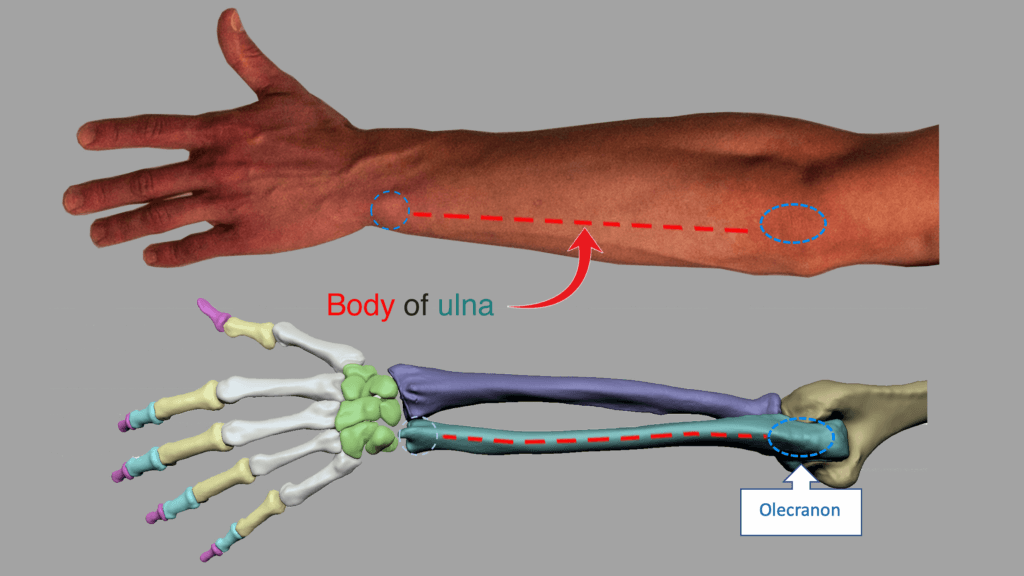
Bony landmarks of the ulna include the olecranon, distal head of ulna, and body of ulna. The body of ulna makes a straight line between the distal head and olecranon.
Regardless of whether the arm is in the anatomical position or turned, you can always make out this straight (or a bit curved) line between the olecranon and the distal head of the ulna. The body of the ulna is an essential and practical bony landmark because it marks the border between the flexor muscles and the extensor muscles of the forearm.

The body of ulna is a bony landmark that separates the flexor muscles and the extensor muscles of the forearm.

A very prominent bony landmark of the ulna is the distal head. It’s above the pinky finger at the height where a wristwatch would go.
Pronation and supination of the forearm happen when you turn your hand. During supination, the palm faces forward, and the thumb points laterally, just like in the anatomical position we already mentioned.
Or, if your arm is bent and supinated, the palm of your hand will be facing the sky. During supination, the ulna and the radius are parallel to each other.
When the arm is pronated, the thumb points toward the body, and the palm faces backward. During pronation, the ulna and the radius cross each other and are no longer parallel.
Rey Bustos has developed an association that helps distinguish between supination and pronation. Supination sounds a bit like it has something to do with soup. Indeed, when carrying soup in the palm of your hand, your arm is supinated.
Pronation sounds a bit like it has something to do with pros. Indeed, if you played basketball as a pro, you’d pronate your hand. The picture below makes it very clear!
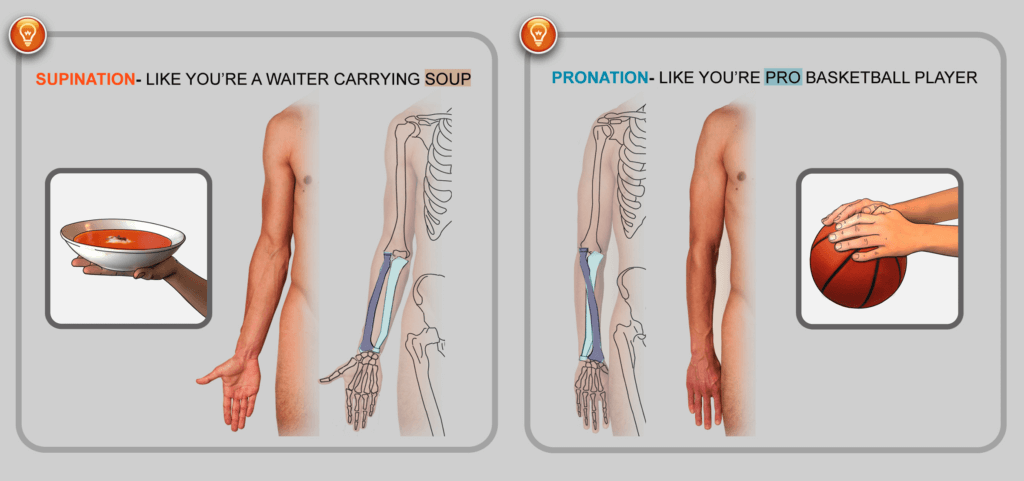
Supination is like carrying soup, and pronation is like playing basketball like a pro.
Let’s look at how pronation and supination look when we view the movement mechanics. It’s important to remember that the elbow has two joints while the hand side has only one joint. That’s because the ulna doesn’t articulate with the bones of the hand.
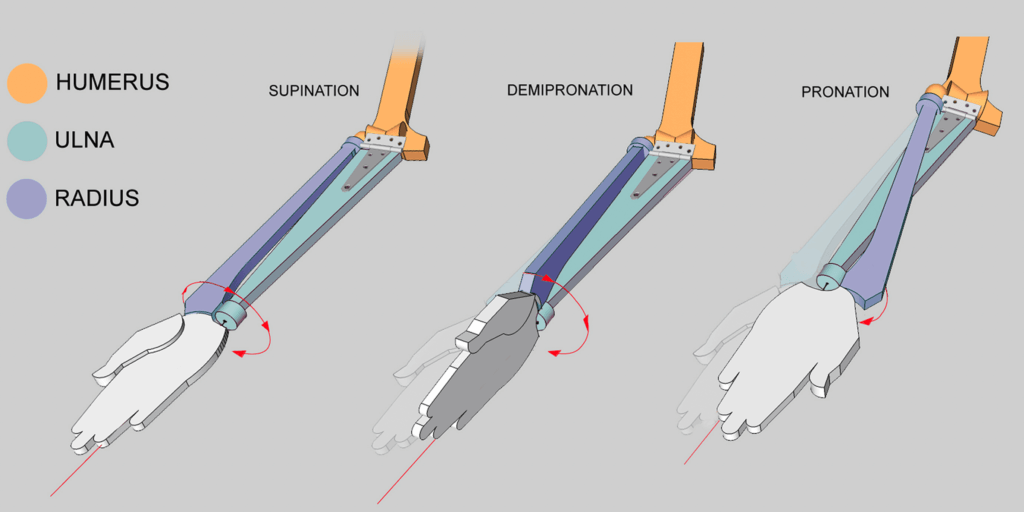
Mechanics of pronation and supination: the radius rotates around the ulna and they end up switching places.
At the elbow, the ulna articulates with the humerus forming a hinge joint, which is not involved and doesn’t move during pronation. But beside it, there’s also the joint where the radius and the humerus meet. The humerus features a ball-like protrusion, and the radius has a cylindrical end that fits on the ball and rotates during supination and pronation of the hand.

Mechanics of pronation and supination at the elbow: the hinge joint of the ulna is not involved in the movement, but the radius rotates at it’s joint with the humerus.
Also on the hand side, the ulna doesn’t move at all. This whole bone serves as an axis for the movements of the radius: that’s how supination and pronation happen. The distal end of the radius goes over the motionless distal end of the ulna, and as a result, the bones cross during pronation.
To sum up the mechanics of pronation, the radius is to blame: it rotates at the elbow and crosses the ulna at the wrist. At the elbow, the bones remain in the same position in relation to each other, but at the wrist, they switch their places.
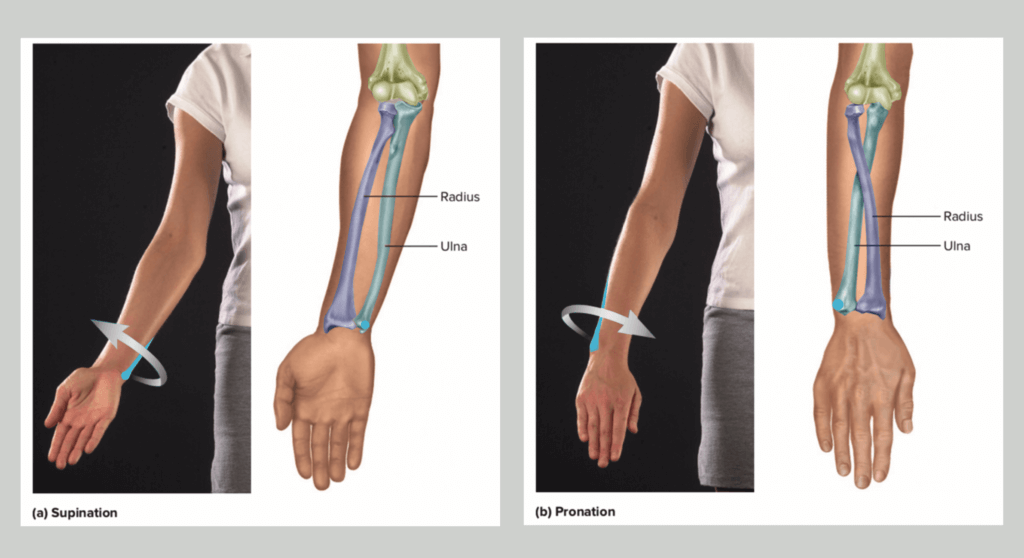
On the left: position of the radius and ulna during supination; on the right: position of the forearm bones during pronation.
In the picture below, you can see the cross sections of the arm at the deltoid tuberosity, elbow, mid-forearm, and wrist. Notice the changes in how much each of them shifts as the arm gets supinated and pronated.

Cross sections of the arm at the deltoid tuberosity, elbow, mid-forearm, and wrist during pronation.
Here’s another view of how different bony landmarks of the upper limb move around as you supinate and pronate your arm. Notice that the elbow rotates outwards during forced pronation, indicating movement in the shoulder, where the deltoid muscle gets worked.

As the arm gets lifted, the distal end of the clavicle becomes invisible.
Marked with the dots are the deltoid tuberosity, olecranon, and distal head of the ulna – the bony landmarks that help you follow the muscle attachments as the arm gets pronated.

As the arm gets lifted, the distal end of the clavicle becomes invisible.
We’ve also prepared videos that explain the anatomy of the arm and look at the upper limb bony landmarks. In them Uldis Zarins explains the topography, morphology and physiology of the upper arm and the forearm.
Watch the video about the upper arm and the humerus here!
To explore how the forearm works during supination and pronation and learn about the bony landmarks of the ulna and radius, watch the video here!
Be the first to get news about our upcoming discounts, books, tools, articles and more! No spam, just the good stuff.

3D Reference Tool is much more than just a library of scans. Here, you will find 3D anatomy references – block-outs, anatomy models, and realistic assets – to help you understand and create realistic human anatomy.
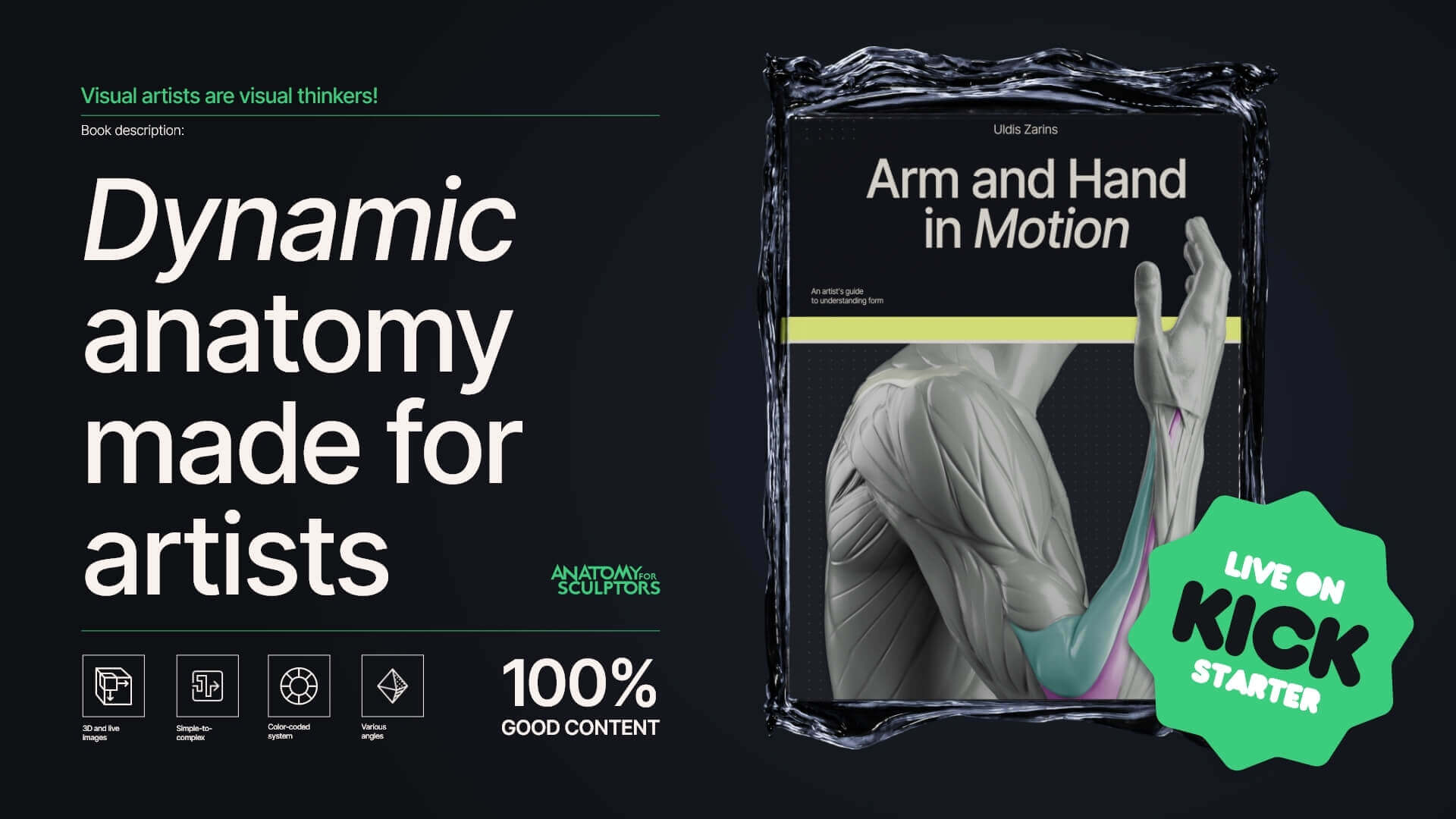
This book takes the complex topic of dynamic anatomy and makes it clear through the power of visual language – various 3D models, live reference images, and color-coded diagrams.
Shop